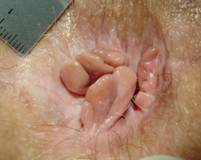Many Americans experience hemorrhoids. The exact prevalence is unknown because most patients are asymptomatic and do not seek care from a physician. It may affect approximately half the population by the age of 50. Hemorrhoids are more prevalent in persons 45 to 65 years of age.
Although the precise cause is not well understood, hemorrhoids are associated with intrinsic weakness in rectal hemorrhoidal tissues with conditions that increase pressure in the hemorrhoidal venous plexus, such as straining during bowel movements secondary to constipation. Other risk factors include obesity, pregnancy, constipation, chronic diarrhea, anal intercourse, and pelvic floor dysfunction.
Hemorrhoidal size, location, and thrombosis, determine the extent of pain or discomfort. Internal hemorrhoids, proximal to the dentate line, are traditionally graded from I to IV based on the extent of prolapse. External hemorrhoids and anal tags, distal to the dentate line, develop secondary to internal hemorrhoids or result of thrombosis.
The ideal treatments for early stages of internal hemorrhoids are always debated. Some are more effective but are more painful, others are less painful but their efficacy is also lower. Thus, comfort or efficacy is a major concern.
Medical management (e.g., stool softeners, topical over-the-counter preparations), dietary modifications (e.g., increased fiber and water intake), and behavioral therapies (good toilet habit, sitz baths) are the mainstays of initial therapy.
If conservative management is unsuccessful, office-based, non-surgical treatments of grades I to III are the preferred next step and the common treatment options include infra-red coagulation and rubber band ligation. The studies showed that band ligation, although more effective in controlling symptoms and obliterating hemorrhoids, is associated with more pain and discomfort to the patient. As infrared coagulation can be conveniently repeated in case of recurrence, it could be considered to be a suitable alternative office procedure for the treatment of early stage hemorrhoids.
Excisional hemorrhoidectomy leads to greater surgical success rates but also incurs more pain and a prolonged recovery than office-based procedures; therefore, hemorrhoidectomy should be reserved for recurrent or higher-grade disease.
3 KEY BENEFITS OF INFRARED COAGULATION THERAPY FOR INTERNAL HEMORRHOIDS
Infrared coagulation is quick and near painless
Infrared coagulation can reduce or eliminate the hemorrhoid with a series of a few quick and near painless treatments using short bursts of hot light.
The primary benefits of infrared coagulation are the quick and near painless treatments. While a series of 3 or 4 treatments is normally required over a 2 month period to reduce hemorrhoid, the individual treatments only take a few minutes, and require no recovery time. This is a big perk compared to taking several days off for surgery and recovery, which can be required in the most severe cases.
Infrared coagulation is nonsurgical
While many people associate hemorrhoids with painful surgery, only a small percentage of patients actually require surgery. Hemorrhoidectomy is a surgical procedure to remove most severe hemorrhoids. Instead, infrared coagulation, or other nonsurgical treatments, can reduce or eliminate the source of a hemorrhoi. The treatment is performed right in the office with no anesthesia, incisions, or stitches.
Infrared coagulation is effective
Nonsurgical treatments are simple, quick and convenient, but they must also offer a certain level of effectiveness. To that end, infrared coagulation is up to 95% effective.
If you’d like to see how infrared coagulation can help you, give Procedure Clinic a call today at (952) 922-2151 to schedule a consultation. You can enjoy lasting relief from hemorrhoid pain!
 Anoscopy is a simple medical procedure that can help your doctor identify an abnormality in your anus and distal rectum.
Anoscopy is a simple medical procedure that can help your doctor identify an abnormality in your anus and distal rectum. Have you been using too much toilet paper because of pesky anal tags? Hemorrhoidal skin tags are flaps of skin or flesh found around the anus. They often form as a result of an existing hemorrhoid.
Have you been using too much toilet paper because of pesky anal tags? Hemorrhoidal skin tags are flaps of skin or flesh found around the anus. They often form as a result of an existing hemorrhoid. 



